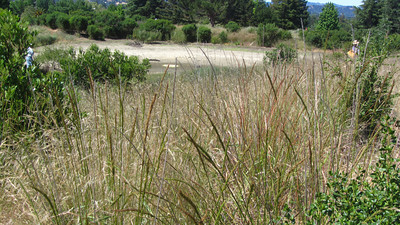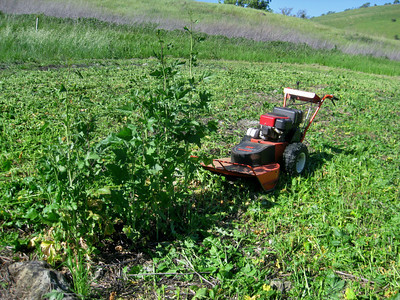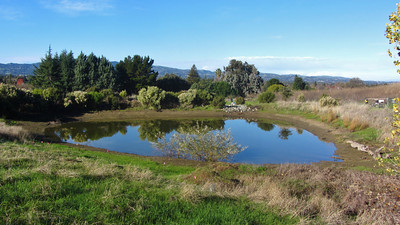Please let us know if you have any questions or would like to volunteer at or donate to any of our projects.
Open Space Restoration Projects
Oak Habitat RestorationBayberry Pond Restoration
Heather Farm Nature Area Restoration
Quail Habitat Restoration
Chaparral Habitat Restoration
Deer Lake Retoration
Shell Ridge Weed Eradication
Bluebird Population Assistance
Land Acquisition
Our Native Plant Nursery
Other Restoration Projects
Open Space Restoration Practices
When the Spanish came to California, they brought with them not only cattle but also many Mediterranean grasses that were native to Spain. These annual grasses use water very intensively and competed strongly with the perennial bunch grasses native to this area. While the native grasses have not disappeared completely, they are far less common than they once were. The rest of the plant community that accompanies bunch grass -- yarrow with fern like leaves, blue-eyed grass with angular shoots and dark blue flowers, yellow buttercups and soapweed -- has also become less common. The Walnut Creek Open Space Foundation's native grass restoration project is attempting to learn how we can make native grass and its associated plant community more prevalent in our open space.
Stand of native Elymus glaucus "blue wildrye" growing near Bayberry pond in Lime Ridge
Promoting the Recovery of Native Grass
Over a period of several years we have planted several plots of native grass -- primarily purple needlegrass ( Nasella pulchra). We gather seed from native grass patches within Shell Ridge and plant them in flats. After the first winter rains, we transfer them to plots in the open space. Our most successful plot is near the Marshall Drive entrance to Shell Ridge at the site of the helicopter crash a few years ago. About 40 grass plants have survived.In 1997, we acquired a sickle-bar mower which is well suited to mow tall grass and weeds in uneven ground. We mow stands of mixed annual and native grass to suppress the normal production of seed by the annual grasses. We plan to use this technique around the edges of native grass stands to allow the stands to expand.
Controlling Exotic Pest Plants

Patch of Black Mustard being mowed down in Shell Ridge in preperation for future native plant restoration
The Foundation is using our sickle-bar mower and our rotary mower to cut down patches of mustard and thistles. Our goal is to first prevent the further spread of these pest plants and then to reclaim part of the area they now cover. While the area covered by pest plants in the open space is too large for us to mow completely, we can target the edges of some pest plant patches and keep them from growing.

Native habitat restoration area Bayberry Pond
Riparian Habitat Restoration
Water is scarce in the west and riparian habitat in the Open Space is limited, consisting of old farm ponds, a few natural springs, and creek beds that are wet only when it rains. Many of the farm ponds dry up towards the end of the summer, especially in years when the rains have been light, making it even more difficult for wildlife to find a place to get a drink. However, all four Open Spaces have some riparian habitat.A healthy riparian habitat has other benefits in addition to water. First is shade and the cooler temperatures it brings. Second is increased biodiversity. Even though water may not flow all year, moisture remains in the soil and provides sustenance for plants that need more water. It also provides niches for animals that would not be in the Open Space otherwise, either because they need additional moisture themselves or they depend on plants that do. Third, it can function as a migration corridor, providing constant cover and a variety of food sources.
Riparian habitat extends only as far as the influence of the water at its heart. This is rarely more than a hundred feet measured horizontally from the top of bank and is usually much less. Obviously it depends on the amount of water present and the nature of the terrain. A pond or spring will create an island of riparian habitat in a sea of whatever surrounds it, and a creek will create a ribbon of habitat along its course.




 Join
Join Donate
Donate Volunteer
Volunteer Maps
Maps Newsletter
Newsletter Facebook
Facebook
